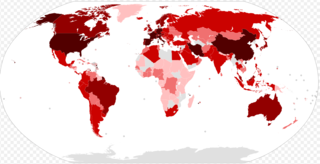Coronavirus Disease 2019
Next Steps
Looking at the next months and years living with COVID-19.
Posted March 22, 2020 Reviewed by Kaja Perina
It’s Sunday, March 22, 2020. I’m near Boston, Massachusetts. Our schools have been closed for a week, all gatherings are limited to 25 people or less, and we are encouraged to stay home as much as possible. The ICU beds in our city are starting to fill with numerous patients. Our hospitals aren’t running out of personal protective equipment yet, but they’ve locked down sanitizer and masks and are working on repurposing plans in case things get bad. You can see the fear and inevitability from this interview with area ICU physician @laxswamy on CNN. Other areas have already run out of gear, and are in desperate need. There are many crowdsourced methods of trying to help, and vets, painters, and dentists have been encouraged to donate for the emergency while national manufacturing ramps up.

An avalanche is coming. The peak of the epidemic to cities all across the United States, with some lag of weeks, over the next 2-3 months. We could see it coming since mid-January at least, and yet we are not prepared. There is a lot of fear, and some disdain for both the fear and the measures taken to keep hospitals from being overwhelmed. In the last post, I reviewed the reasons why we should have locked down several weeks ago. Nothing in the last two weeks has changed my mind. With case fatalities in health care workers climbing, and rapid progression to severe illness even in young adults with no way to predict who or why, no adult can consider themselves somehow invulnerable. There is no knowledge about long term sequelae, including possible long term lung damage, heart damage, and other unexpected risks such as male sterility.
This last risk is extremely preliminary; Wuhan doctors made the recommendation that recovered men get their fertility checked, but their article was later (reportedly) taken down by the Chinese government. However, there is a plausible mechanism, as severe testicular inflammation was seen in some (but by no means all, this is not the movie Children of Men) in the very similar SARS infection in the early 2000s.
I mention this not to frighten people. The more severe the infection, the more multiple organ systems are involved and the more long term problems there will be. There is no reason to think a mild infection would have these long term sequelae, but we really don't know what the future holds with this disease. The uncertainty is the point.
There is preliminary evidence primates similar to humans develop immunity after infection, but we have no knowledge about how long immunity to the virus might last. It is irresponsible to not do everything to contain the epidemic, which, in the US, without widespread mass testing (in the millions at this point), means physical isolation as much as possible.

But it doesn’t help much to fear, other than to spur appropriate action, for which we need knowledge about what is likely to happen. Let me be clear, these are not my ideas. These are distilled from various experts across epidemiology, virology, and public health, and from close observation of events across the world as they have occurred. One of these ideas conflicts with the official recommendations of the CDC. I will explain my reasoning and possible fallacies, but keep that in mind.
First off, what can you do? Stay home as much as possible. When you do need to go out, buy in bulk, to the extent of what your family will need for a couple weeks (this is not hoarding, this is limiting number of exposures to other people, and it is a credible way to slow the epidemic). Change your habits and business models. Restaurants need to shift to online ordering and pick-up or delivery. Teaching, medicine, music lessons, dance, karate, other services need to switch to virtual models as much as possible. If your state isn’t locked down yet, start doing this and planning for this right now. We planned for a month and the changeover to last week seemed frantic and sudden at the time.
Some services can’t be virtual, such as housecleaning, medical, waitstaff, kayak guide…a million other services jobs, not to mention support industries for tourism and travel. Other essential services must keep working out in the world, like trash pick-up. Other people, many elderly and disabled, will be cut off during this time. If you have the means, donate to local food banks (they like money, not food, so they can buy in bulk). Facebook is the best site for hyperlocal services, our town site has organized a group to do shopping and pharmacy pick up for the elderly and even to organize online library storytelling, scavenger hunts around the neighborhood that can be done from bikes and cars, etc.
What is our way out of this? Ultimately, the best long term hope is a vaccine. The good news is there are already some candidates either in phase 1 human trials or about to be, if funding can be arranged. The best immediate hope for treatment and perhaps prophylaxis for high-risk individuals is convalescent serum, a process of taking antibodies to the disease from recovered people and distributing them to the ill and high risk. For more details please listen to this podcast, or read this article. Blood banks are already working on this strategy. There are also numerous drug trials ongoing. I would caution against the recent excitement for malaria drugs across twitter and even mentioned at the presidential press conference. It definitely deserves a big clinical trial, but these drugs have pretty serious side effects at the doses needed for COVID-19, some of which affect the heart. Since COVID-19 also affects the heart, there are many reasonable concerns about the risks.
Ultimately our path to greater freedom before a vaccine is available is twofold: massive testing (to isolate clusters and to find recovered patients for convalescent serum) and better hygiene. Some of this is already being done in other countries. Industries like airlines, gyms, bus lines, movie theaters need to figure out a way to change HEPA filters and sanitize doors, seats, and equipment between flights or showings, or use antimicrobial coatings on doorknobs, etc. In Rwanda, a bus line created handwashing stations and no one is allowed to board the bus without washing. In Taiwan, Hong Kong, Singapore, and South Korea, places that have done a good job controlling their outbreaks for now, there is far more mask-wearing in public. This is where I differ from the CDC in that I think this is a good idea. Let me explain.
The original reason to avoid masks as voiced by the CDC was to leave masks for health care workers (yes, they are much more likely to be exposed), and that surgical masks do almost nothing to prevent infection from others (this is more controversial than I believed originally), and perhaps give you a false sense of security. They do keep *your germs* from passing on to others in the waiting room by containing cough. The CDC reasoning made sense to me at first, and I even repeated it, but I have since changed my mind. In Asian cities, people don’t wear masks to protect themselves, they wear masks out of politeness in crowded cities to protect others from their germs. If everyone goes out and about with a mask, then no one is coughing on touch screens, and there is a barrier between the nose and mouth and the fingers. Yes, people will still be gross and reach under the mask, but education may help. Most data about masks becoming contaminated is from hospitals, not populations.
Think of it this way… we know that asymptomatic infection has driven a lot of infection in some areas. We are told to act as if we are infected to prevent spread. People who are infected or even showing minor cold symptoms should be staying home, but if they must go out (for example to the pharmacy or doctor), should be scrupulous with hand washing, not touching their face, and wearing a mask. The Asian countries that have more universal mask-wearing and less handshaking seem to be doing much better containing the virus. In this study, wearing masks in public was positively associated with other good hygiene practices.
I think in this time of dangerous shortages, all surgical and N95 masks should be shunted directly to hospitals and clinics on the front lines, but there is nothing wrong with wearing your own homemade mask, provided you don’t think it makes you invulnerable and you adjust it carefully, without touching your face and wash it or put it aside for a day when you come home. Getting everyone stuck at home to make masks gives the public something to do besides worry. For this strategy to help, it has to be with education and to be nearly universal. And no, I don’t feel the same way about gloves, at all, unless you are experienced with wearing gloves in settings where you know how not to contaminate self or others, it is very easy to misuse gloves in the public setting.
Testing, hygiene, and science can get us out into the world again, but we all have to do this together. I wouldn’t wait for the government; make a plan for yourself, your business and family and locality now. Don’t get me wrong, there is much the government could do (that’s a whole other post!), but I’m not seeing much coordinated action on a federal level right now, and we have little control over what happens there for the time being. We need helpful things to do on a local level, for our communities, now. Stay safe if possible and wash your hands. The fewer contacts you have, the fewer people end up in emergency rooms and on ventilators, the sooner the peak danger ends, and the sooner we get out and about again.
Copyright Emily Deans MD




